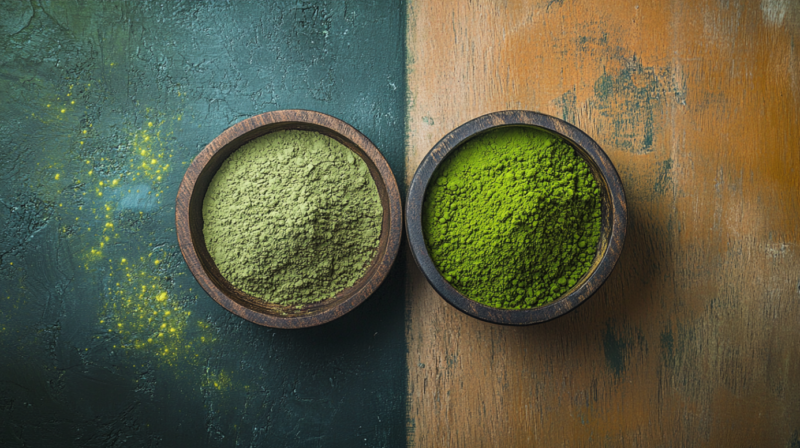Each promises life-changing results, with Instagram captions shouting wellness from every latte. But let’s get real: nobody wants another green dust sitting forgotten in the pantry next to that weird protein powder you bought last year.
As someone who knows the value of getting maximum mileage from every bit of fuel (think premium gas versus regular unleaded, but for your body), here’s the straight-up truth: matcha offers smoother energy and sharper focus, perfect if caffeine and calmness speak your language.
Moringa, however, is your caffeine-free, nutrient-packed powerhouse, ideal if you’re chasing immune boosts and inflammation-fighting magic.
Botanical Origins and Cultivation Methods
Matcha: Japanese Tradition and Cultivation
What Is So Special About Matcha? The Origins of Japanese Tea Culture https://t.co/J4CAPhpPFH #japanesematcha #japanmatcha #matcha #matchaproperties
— Guidable (@Guidable_info) January 10, 2025
Matcha tea originates from Japan and has been cultivated meticulously for over eight centuries.
The leaves are sourced specifically from the Camellia sinensis plant, traditionally shaded for approximately three weeks before harvesting.
Shading triggers physiological changes, including increased chlorophyll production and elevated amino acid content, notably L-theanine.
Following harvest, leaves are steamed, air-dried, and ground into an exceptionally fine powder. This careful production process enhances the bioavailability of nutrients.
Moringa oleifera, often referred to as the “Miracle Tree,” originated in the Himalayan foothills of northern India but is now extensively grown in subtropical and tropical regions globally, including Africa, South America, and Southeast Asia. Moringa thrives in challenging conditions, such as drought and nutrient-poor soils, making it a sustainable nutritional resource. The leaves are harvested, dried naturally, and ground into powder, maintaining high nutrient density. Matcha tea is recognized primarily for its rich concentration of antioxidants, particularly epigallocatechin gallate (EGCG). A study published in NCBI demonstrated that matcha tea contains approximately 137 times more EGCG than standard green teas, conferring considerable anti-inflammatory and antioxidative effects. Moreover, Matcha uniquely combines caffeine (~70 mg per teaspoon) with the amino acid L-theanine (~34 mg per teaspoon), creating a synergistic effect. Clinical trials (Dietz & Dekker, Nutrients, 2017) have shown this combination promotes sustained attention, improved cognitive function, and reduced psychological stress compared to caffeine alone. In contrast, moringa powder functions nutritionally as a comprehensive multivitamin supplement. Moringa leaves contain significantly high levels of protein (approximately 2 grams per tablespoon), vitamin C, vitamin A, calcium, and iron. A 2015 controlled study in the Journal of Food Science and Technology demonstrated moringa’s efficacy in correcting nutritional deficiencies in iron and vitamin A among malnourished populations. Moreover, moringa contains bioactive compounds such as quercetin and chlorogenic acid, renowned for their antioxidant and anti-inflammatory capabilities. These unique sensory characteristics stem primarily from its cultivation and processing methods. Shaded growing conditions enhance the accumulation of amino acids, specifically L-theanine, which contributes to the tea’s signature sweet and savory flavor notes. While some initial consumers might perceive matcha’s slight bitterness, proper preparation (correct water temperature around 70–80°C and controlled whisking techniques) notably reduces any bitterness, resulting in a smooth, palatable beverage. Matcha’s refined sensory profile enables versatile culinary use beyond beverages, extending to desserts, baked goods, and even savory dishes. Its mildness and umami attributes are particularly appealing to consumers seeking an enjoyable daily ritual, evidenced by its increasing popularity in latte preparations and café offerings worldwide. Due to minimal processing, moringa maintains its naturally intense taste, which many first-time consumers find overpowering if consumed directly. The bitterness and vegetal notes result primarily from its abundant polyphenolic compounds, including quercetin and chlorogenic acid. Because of moringa’s intense flavor, culinary applications typically involve masking strategies. Consumers frequently blend moringa powder with fruit-based smoothies, citrus juices, or strongly flavored foods to offset bitterness. Integrating moringa into savory dishes, soups, sauces, or salad dressings proves effective, highlighting its earthy notes positively rather than negatively. Matcha tea possesses scientifically validated benefits primarily associated with cognitive function, metabolism, and cardiovascular health. One of Matcha’s distinct attributes is its combination of caffeine and L-theanine, which supports improved cognitive performance and reduced anxiety. Clinical trials indicate notable enhancements in attention span, focus, and memory retention following matcha consumption. Additionally, research underscores Matcha’s positive effects on metabolism. Regular consumption correlates with increased fat oxidation rates, potentially facilitating weight management. Matcha’s cardiovascular benefits stem primarily from its abundant antioxidants, particularly epigallocatechin gallate (EGCG), which supports cardiovascular health through the reduction of inflammation and the improvement of cholesterol levels. Known for its immune-enhancing properties, moringa’s significant antioxidant content—including quercetin, chlorogenic acid, and vitamins A and C—strengthens immune function and reduces systemic inflammation. Clinical evidence highlights moringa’s anti-inflammatory activity, indicating a potential for managing chronic inflammation conditions. Furthermore, moringa shows strong evidence in regulating blood sugar levels, making it beneficial for managing diabetes or insulin sensitivity. Clinical studies demonstrate that regular moringa supplementation reduces fasting blood glucose and improves insulin sensitivity in diabetic individuals. Due to its nutrient-dense profile, moringa effectively addresses nutritional deficiencies, particularly iron and vitamin A, leading to improved overall nutritional status. Matcha requires meticulous cultivation, including extensive manual labor for shading, selective harvesting, and precise processing. Consequently, these production methods contribute to matcha’s relatively higher cost—often ranging from $20 to $40 per 100 grams according to Ksumi Tea. From an environmental standpoint, intensive water use, fertilizer application, and energy requirements for precise grinding processes are potential sustainability concerns. Consumers interested in sustainability should prioritize certified organic or ethically sourced matcha products. Conversely, moringa production demonstrates inherent economic and environmental advantages. The tree thrives with minimal water, tolerates poor soil quality, and grows rapidly under harsh climatic conditions. Thus, moringa cultivation can positively impact local economies, particularly in developing regions. Market prices for moringa are considerably lower, typically ranging between $10–$20 per 100 grams, making it widely accessible as a nutrient-dense dietary supplement. After closely examining both matcha and moringa, here’s my straightforward conclusion: Matcha is the superior choice overall. Here’s why. While moringa is undeniably powerful—offering dense nutrition, strong immune support, and proven anti-inflammatory benefits—its intense, bitter taste and limited flexibility in daily use make it tougher to integrate consistently into most diets. Matcha, on the other hand, excels in its pleasant taste, smooth texture, and remarkable versatility, effortlessly becoming part of your daily routine (think lattes, smoothies, baking—you name it). Beyond taste and convenience, matcha’s combination of caffeine and L-theanine provides a unique cognitive edge. For anyone seeking enhanced focus, calmer energy, or improved mental performance throughout the day, matcha delivers clear, scientifically backed results. Its powerful antioxidants further reinforce long-term benefits like metabolism boosting and cardiovascular protection, making it a reliable investment in your overall wellness. In short, if you’re after something delicious, adaptable, and highly effective at boosting energy and cognitive function, matcha wins definitively. Moringa still deserves a place as a nutritional supplement—especially for caffeine-sensitive individuals—but matcha’s comprehensive benefits and greater usability put it ahead as the smarter, more practical choice for everyday health.
Attribute
Details
Scientific Name
Camellia sinensis
Region of Origin
Japan (primarily Uji and Nishio regions)
Cultivation Technique
Shade-grown (20–30 days before harvest), steamed and dried
Primary Active Compounds
Caffeine, L-theanine, catechins (EGCG), chlorophyll
Traditional Usage
Zen Buddhist meditation, ceremonial tea rituals
Moringa: A Global Nutritional Resource
Attribute
Details
Scientific Name
Moringa oleifera
Region of Origin
India; widely cultivated in Africa, Asia, and Latin America
Cultivation Technique
Natural drying of leaves, minimal processing
Primary Active Compounds
Vitamins (A, C), minerals (iron, calcium), antioxidants (quercetin), protein
Traditional Usage
Nutritional supplementation, traditional medicine (Ayurveda)
Comparative Nutritional Analysis
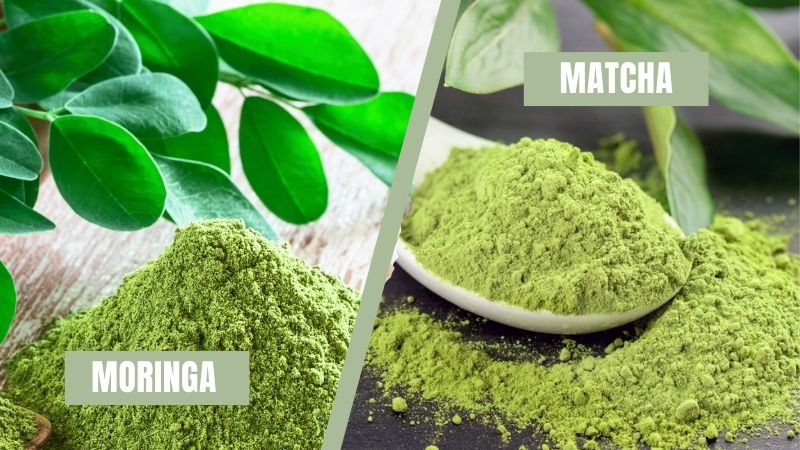
Matcha: Antioxidants and Cognitive Enhancers
Nutrient
Amount
Health Implication
Caffeine
~70 mg
Cognitive enhancement, increased alertness
L-Theanine
~34 mg
Reduces anxiety, improves mood
EGCG (catechin)
~60 mg
Strong antioxidant, anti-inflammatory properties
Vitamin C
~1.75 mg
Immune function, skin health
Moringa: Comprehensive Multinutrient Density
Nutrient
Amount
Health Implication
Protein
~2 g
Essential amino acids, muscle synthesis
Vitamin C
~6 mg (10% DV)
Immune support, antioxidant function
Vitamin A
~250 IU
Vision health, cellular repair
Calcium
~100 mg
Bone mineral density, muscle function
Iron
~0.5 mg
Hemoglobin synthesis, energy production
Organoleptic Characteristics—Taste and Palatability
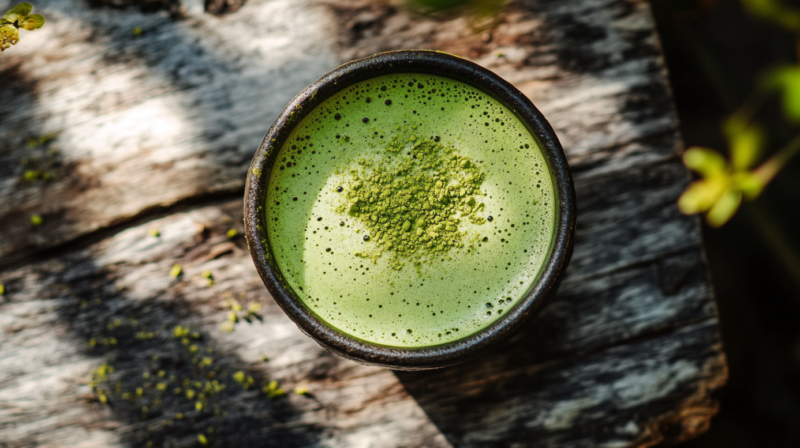
Matcha: Mildly Sweet with Balanced Complexity
Sensory Dimension
Description
Flavor Intensity
Moderate
Dominant Flavors
Earthy, grassy, subtly sweet, umami
Bitterness Level
Mild; easily moderated through correct preparation
Typical Culinary Uses
Lattes, smoothies, pastries, ice cream, and gourmet dishes
Moringa: Robust, Earthy, and Distinctly Bitter
Sensory Dimension
Description
Flavor Intensity
High
Dominant Flavors
Grassy, earthy, peppery, markedly bitter
Bitterness Level
Significant; requires blending with complementary flavors
Typical Culinary Uses
Fruit smoothies, savory recipes, sauces, soups, salad dressings
Scientifically Documented Health Benefits
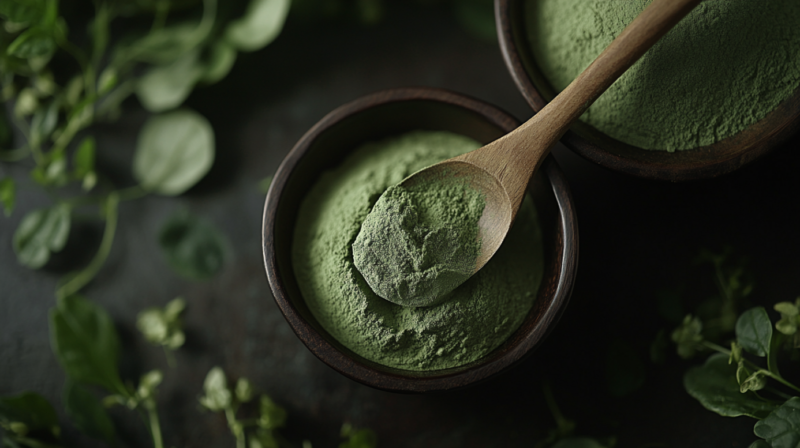
Matcha: Cognitive Enhancement, Cardiovascular Health, and Metabolic Advantages
Health Benefit
Mechanism and Impact
Cognitive Function
Enhances focus, memory, and cognitive clarity due to caffeine and L-theanine interaction
Metabolic Enhancement
Increases calorie burning and fat oxidation, aiding weight management
Cardiovascular Support
Reduces cholesterol, improves blood vessel function due to high antioxidant content (EGCG)
Moringa: Immunity Support, Anti-Inflammatory Properties, and Blood Sugar Regulation
Health Benefit
Mechanism and Impact
Immune System Enhancement
Rich antioxidants and vitamins improve immune function and reduce oxidative stress
Anti-inflammatory Effects
Reduces inflammation markers, beneficial for chronic inflammatory conditions
Blood Sugar Management
Lowers blood glucose and improves insulin response, aiding diabetes management and prevention
Environmental Sustainability
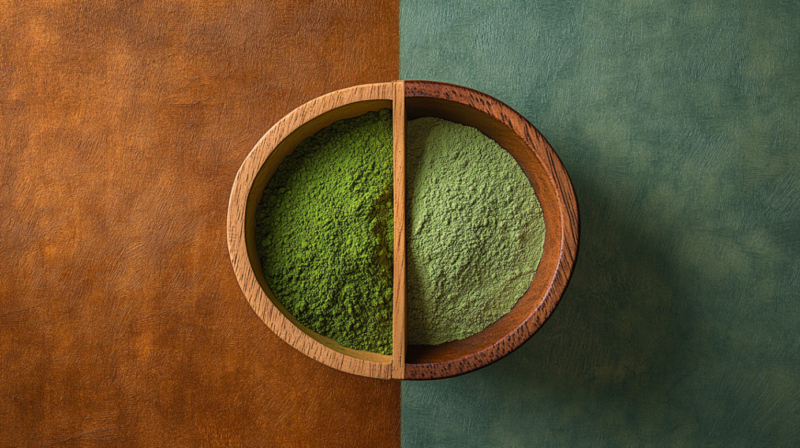
Matcha: Resource-Intensive Premium Product
Attribute
Details
Cost per 100 grams
$20–$40 (premium-grade)
Environmental Impact
Higher water and energy consumption, labor-intensive cultivation
Sustainability Measures
Organic certification, and transparent sourcing recommended
Moringa: Economically Viable and Environmentally Sustainable
Attribute
Details
Cost per 100 grams
$10–$20 (economical)
Environmental Impact
Low water consumption, adaptable to drought conditions
Sustainability Measures
Supports small-scale farming, sustainable economic development
Bottom Line

